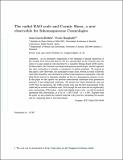Por favor, use este identificador para citar o enlazar a este item:
http://hdl.handle.net/10261/17830COMPARTIR / EXPORTAR:
 SHARE SHARE
 CORE
BASE CORE
BASE
|
|
| Visualizar otros formatos: MARC | Dublin Core | RDF | ORE | MODS | METS | DIDL | DATACITE | |

| Campo DC | Valor | Lengua/Idioma |
|---|---|---|
| dc.contributor.author | García-Bellido, Juan | - |
| dc.contributor.author | Haugboelle, Troels | - |
| dc.date.accessioned | 2009-10-20T11:06:45Z | - |
| dc.date.available | 2009-10-20T11:06:45Z | - |
| dc.date.issued | 2009-09-22 | - |
| dc.identifier.citation | Journal of cosmology and astroparticle physics 09(028): (2009) | - |
| dc.identifier.issn | 1475-7516 | - |
| dc.identifier.uri | http://hdl.handle.net/10261/17830 | - |
| dc.description | 18 pages, 5 figures, 1 table.-- pre-print archive. | - |
| dc.description.abstract | As an alternative explanation of the dimming of distant supernovae it has recently been advocated that we live in a special place in the Universe near the centre of a large spherical void described by a Lemaître-Tolman-Bondi (LTB) metric. In this scenario, the Universe is no longer homogeneous and isotropic, and the apparent late time acceleration is actually a consequence of spatial gradients. We propose in this paper a new observable, the normalized cosmic shear, written in terms of directly observable quantities, and calculable in arbitrary inhomogeneous cosmologies. This will allow future surveys to determine whether we live in a homogeneous universe or not. In this paper we also update our previous observational constraints from geometrical measures of the background cosmology. We include the Union Supernovae data set of 307 Type Ia supernovae, the CMB acoustic scale and the first measurement of the radial baryon acoustic oscillation scale. Even though the new data sets are significantly more constraining, LTB models—albeit with slightly larger voids—are still in agreement with observations, at χ2/d.o.f. = 309.1/(310−4) = 1.01. Together with the paper we also publish the updated easyLTB code used for calculating the models and for comparing them to the observations. | en_US |
| dc.description.sponsorship | We thank James Zibin, Tirthabir Biswas, and Alesio Notari for interesting discussions. We acknowledge the use of the computer resources at the Danish Centre of Scientific Computing. We also acknowledge financial support from the Spanish Research Ministry, under contract FPA2006-05807 and the Consolider Ingenio 2010 programme under contract CSD2007-00060 “Physics of the Accelerating Universe” (PAU). | en_US |
| dc.format.extent | 640072 bytes | - |
| dc.format.mimetype | application/pdf | - |
| dc.language.iso | eng | en_US |
| dc.publisher | Institute of Physics Publishing | - |
| dc.publisher | International School for Advanced Studies | - |
| dc.rights | openAccess | en_US |
| dc.subject | Dark energy theory | en_US |
| dc.subject | Classical tests of cosmology | en_US |
| dc.subject | Superclusters and voids | en_US |
| dc.title | The radial BAO scale and Cosmic Shear, a new observable for Inhomogeneous Cosmologies | en_US |
| dc.type | artículo | en_US |
| dc.identifier.doi | 10.1088/1475-7516/2009/09/028 | - |
| dc.description.peerreviewed | Peer reviewed | en_US |
| dc.relation.publisherversion | http://dx.doi.org/10.1088/1475-7516/2009/09/028 | en_US |
| dc.type.coar | http://purl.org/coar/resource_type/c_6501 | es_ES |
| item.openairetype | artículo | - |
| item.grantfulltext | open | - |
| item.cerifentitytype | Publications | - |
| item.openairecristype | http://purl.org/coar/resource_type/c_18cf | - |
| item.fulltext | With Fulltext | - |
| item.languageiso639-1 | en | - |
| Aparece en las colecciones: | (IFT) Artículos | |
Ficheros en este ítem:
| Fichero | Descripción | Tamaño | Formato | |
|---|---|---|---|---|
| 0810.4939v1.pdf | 625,07 kB | Adobe PDF |  Visualizar/Abrir |
CORE Recommender
SCOPUSTM
Citations
49
checked on 22-abr-2024
WEB OF SCIENCETM
Citations
59
checked on 25-feb-2024
Page view(s)
360
checked on 22-abr-2024
Download(s)
270
checked on 22-abr-2024
Google ScholarTM
Check
Altmetric
Altmetric
NOTA: Los ítems de Digital.CSIC están protegidos por copyright, con todos los derechos reservados, a menos que se indique lo contrario.
